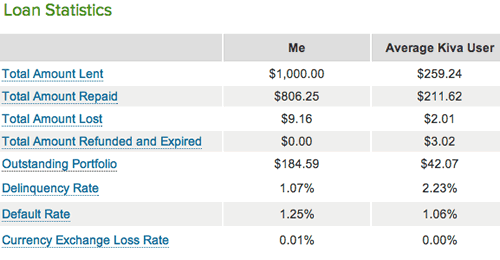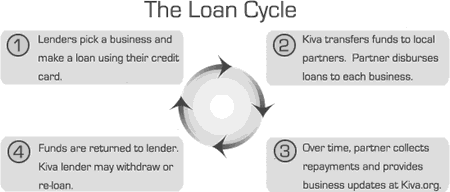
I have been lending some money to people through Kiva microfinance to help alleviate poverty since 2007. While reinvesting some funds that were paid back, I noticed that I just reached $1,000 in money lent out through 40 loans of $25 each. Kiva loans do not pay any interest. Out of the $1,000 that I have lent out, I have received about $805 back, about $185 is outstanding, and I have lost about $10. Now, you should know that the people borrowing this money are paying interest rates much higher than zero but much of that interest goes back to paying operational costs and covering defaults. There has been some debate as to whether this is becoming a form of predatory lending, but I believe there is a real need for such lending in these countries. You also have to trust Kiva in their selection of MFI field partners. I also do microfinance lending at Microplace.
Right now you can get a free $25 trial to try out Kiva using my invite link (I get nothing). You basically get to make a free $25 to a person of your choosing from a developing country, but when it is paid back you the money goes back to the sponsor. I know, rather cheesy. I think you should just have to keep lending it out by making it ineligible for withdrawal. That’s what I like about this type of lending – the money you commit can help many people over time.

 MicroPlace
MicroPlace Kiva
Kiva I’ve
I’ve 

 I’ve been getting back into podcasts while driving, and have been catching up on the Alton Brown podcast. In the Samantha Brown episode, she shared a good tip about international travel and language barriers that I’ve never read in a guidebook: Never go around asking people if they speak English. Even if you say the question in their home language. Because when you say:
I’ve been getting back into podcasts while driving, and have been catching up on the Alton Brown podcast. In the Samantha Brown episode, she shared a good tip about international travel and language barriers that I’ve never read in a guidebook: Never go around asking people if they speak English. Even if you say the question in their home language. Because when you say: Just got an e-mail from MicroPlace that they are running a gift certificate promotion where if you buy a $20 GC, you get another $20 GC free. The gift recipient can then lend out the money to a poor entrepreneur and receive interest + $20 back later. Since the person actually gets the money back (or at least most of it assuming some defaults), and thus isn’t the same as a “$XX has been donated in your name” gift, I think it’s a cool twist on gift cards.
Just got an e-mail from MicroPlace that they are running a gift certificate promotion where if you buy a $20 GC, you get another $20 GC free. The gift recipient can then lend out the money to a poor entrepreneur and receive interest + $20 back later. Since the person actually gets the money back (or at least most of it assuming some defaults), and thus isn’t the same as a “$XX has been donated in your name” gift, I think it’s a cool twist on gift cards.

 Yikes, I’m cutting things close this year. Time to see if there are any last-minute things I need to do with the last two business days before 2008.
Yikes, I’m cutting things close this year. Time to see if there are any last-minute things I need to do with the last two business days before 2008.
 The Best Credit Card Bonus Offers – March 2024
The Best Credit Card Bonus Offers – March 2024 Big List of Free Stocks from Brokerage Apps
Big List of Free Stocks from Brokerage Apps Best Interest Rates on Cash - March 2024
Best Interest Rates on Cash - March 2024 Free Credit Scores x 3 + Free Credit Monitoring
Free Credit Scores x 3 + Free Credit Monitoring Best No Fee 0% APR Balance Transfer Offers
Best No Fee 0% APR Balance Transfer Offers Little-Known Cellular Data Plans That Can Save Big Money
Little-Known Cellular Data Plans That Can Save Big Money How To Haggle Your Cable or Direct TV Bill
How To Haggle Your Cable or Direct TV Bill Big List of Free Consumer Data Reports (Credit, Rent, Work)
Big List of Free Consumer Data Reports (Credit, Rent, Work)